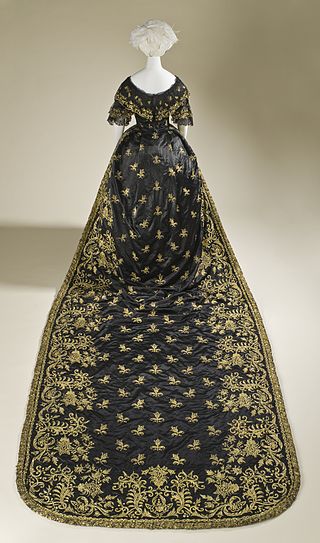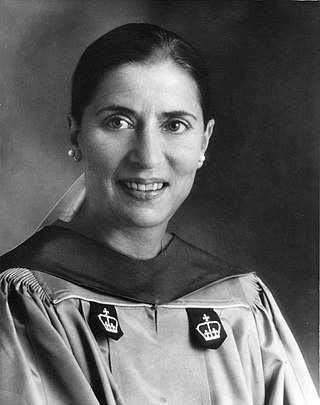
Academic dress is a traditional form of clothing for academic settings, mainly tertiary education, worn mainly by those who have obtained a university degree, or hold a status that entitles them to assume them. It is also known as academical dress, academicals, and, in the United States, as academic regalia.

The University of Oxford has a long tradition of academic dress, which continues to the present day.

The biretta is a square cap with three or four peaks or horns, sometimes surmounted by a tuft. Traditionally the three-peaked biretta is worn by Christian clergy, especially Roman Catholic clergy, as well as some Lutheran and Anglican clergy. A four-peaked biretta is worn as academic dress by those holding a doctoral degree from a pontifical faculty or pontifical university or faculty. Occasionally the biretta is worn by advocates in law courts, for instance the advocates in the Channel Islands.
The academic dress prescribed by the University of Bristol is a mixture of that prescribed by Cambridge and Oxford. Bristol has chosen, for graduates, to mainly specify Oxford-style gowns and Cambridge-style hoods. Unlike many British universities, the hood itself is to be "University red", lined with a specified colour. University red is defined to be Pantone 187. Bristol also specifies that undergraduates are to wear gowns "of the approved pattern" in certain circumstances, although the pattern itself is not specified. This is not too important since, in practice, undergraduates are only required to be gowned when graduating or at dinner as a member of Wills Hall.
The academic and official dress of the University of Warwick dates originally from the mid-1960s, shortly after the university's foundation. Despite persistent offers from Charles Franklyn the theatrical costume designer Anthony Powell was commissioned to design robes for officials and graduates of the university. Due to pressure of other work, and some apparent differences of opinion, Powell withdrew from the project, and the robes for graduates subsequently designed in consultation with J. Wippell and Company of Exeter, with Ede and Ravenscroft designing and making the robes for officials.

The academic dress of the University of Melbourne refers to the formal attire, including robes, gowns, and hoods, as prescribed by the Statutes and Regulations for undergraduates, graduates, officers, and honorands of the university. This follows the style of the University of Oxford for the gowns and hoods for Bachelors and Masters degrees. Melbourne adopts the style of the University of Cambridge for its doctorates. The hoods are all black, resembling the size and shape of the Oxford MA hoods, which are in the simple Burgon shape. These hoods are lined with the color specified for the corresponding faculty or degree and are bound with white on the lower edge for bachelors, while masters' hoods have no binding. The specific faculty or degree colors are outlined in the University Regulations. In the past, Pass degrees were bound in fur and Honours degrees in silk; however, this distinction no longer holds. Bachelors wear an Oxford Bachelors gown, while Masters wear an Oxford Masters gown. The gown for undergraduate students is the same as the bachelors', but its sleeves must not be split.
Academic dress of the University of London describes the robes, gowns and hoods which are prescribed by the university for its graduates and undergraduates.

In clothing, a train describes the long back portion of a robe, coat, cloak, skirt, overskirt, or dress that trails behind the wearer.

As the oldest college in the United States, Harvard University has a long tradition of academic dress. Harvard gown facings bear crow's-feet emblems near the yoke, a symbol unique to Harvard, made from flat braid in colours distinctive of the wearer's qualification or degree. Crow's-feet are double for earned degrees, and triple for honorary degrees.
There are a number of universities in Queensland, Australia, all with distinct academic dress.
The academic dress of the University of Kent is normally only worn at graduation ceremonies. In common with most British universities a graduand begins the ceremony wearing the dress of the degree to which they are being admitted. This is in contrast to the practice at some universities such as Oxford where a graduand only dons the dress of a degree after it has been conferred.
This page describes the different types of academic dress allowed at the University of Exeter. Definitions of the academic dress for the award holders and officials of the university are set out in the university's regulations.

Academic dress prescribed at the Trinity College Dublin follows a relatively complex protocol which, nonetheless, shares some particular characteristics with other universities in Ireland and with its sister institutions at the University of Oxford and University of Cambridge in the United Kingdom.

Academic dress of the University of Manchester describes the gowns, hoods and headwear which are prescribed by the university for its graduates and officers.
The Groves Classification is a numbering system to enable the shape of any academic gown or hood to be easily described and identified. It was devised by Nicholas Groves to establish a common terminology for hoods and gowns to remedy the situation of individual universities using differing terms to describe the same item. As such it is used in same manner as an heraldic blazon whereby a textual description enables a coat of arms to be drawn. The system was first described in the Burgon Society's annual in 2001 and adopted as standard by robe makers and scholars of academic dress.

Academic dress has a history in the United States going back to the colonial colleges era. It has been most influenced by the academic dress traditions of Europe. There is an Inter-Collegiate Code that sets out a detailed uniform scheme of academic regalia that is voluntarily followed by many, though not all institutions entirely adhere to it.

The academic dress of McGill University describes the caps, gowns and hoods which are prescribed by the university for its degree candidates/holders. Until the mid-20th century, McGill also prescribed academic dress for its matriculating or enrolled students as well as its faculty. Founded in 1821, McGill University is consistently ranked as one of Canada's pre-eminent universities, and among the top 20 universities in the world.
The current academic dress of the National University of Ireland was simplified following a review in 1999. The design of the gowns generally follows that of Oxford. The hoods are primarily green, representing Ireland, and generally follow the design of Dublin or Belfast.

The academic regalia of Columbia University are the robes, gowns, and hoods which are prescribed by the university for its graduates. As one of the oldest universities in the United States, Columbia University has a long tradition of academic dress dating back to its founding in the 18th century, when it became the second university in the country to formally adopt academic robes. The development of Columbia's academic regalia has strongly influenced those of most universities in the United States. Since the passing of the Intercollegiate Code of Academic Costume in 1895, the style of academic dress worn at the university in the late 20th century has served as the basis of those of most other universities in the country. Though once worn daily by students at the university, caps and gowns now are only worn during commencement.

The first commencement at Columbia University was held on June 21, 1758, when the university, then known as King's College, conferred seven degrees upon its first graduating class. Today, the university graduates several thousand students each year from its several undergraduate colleges, graduate schools, and affiliated institutions. University Commencement traditionally takes place on the third Wednesday of May.

















